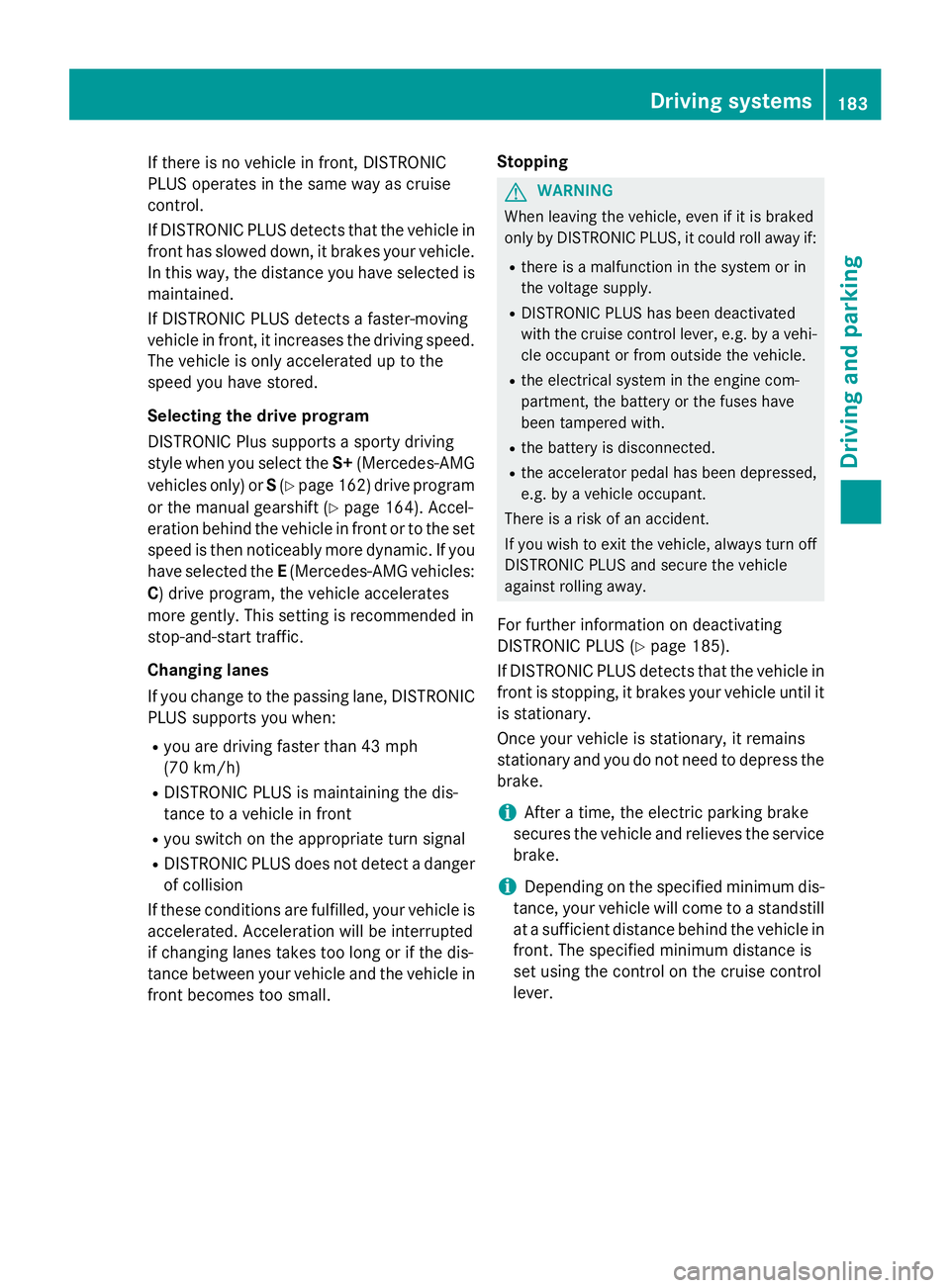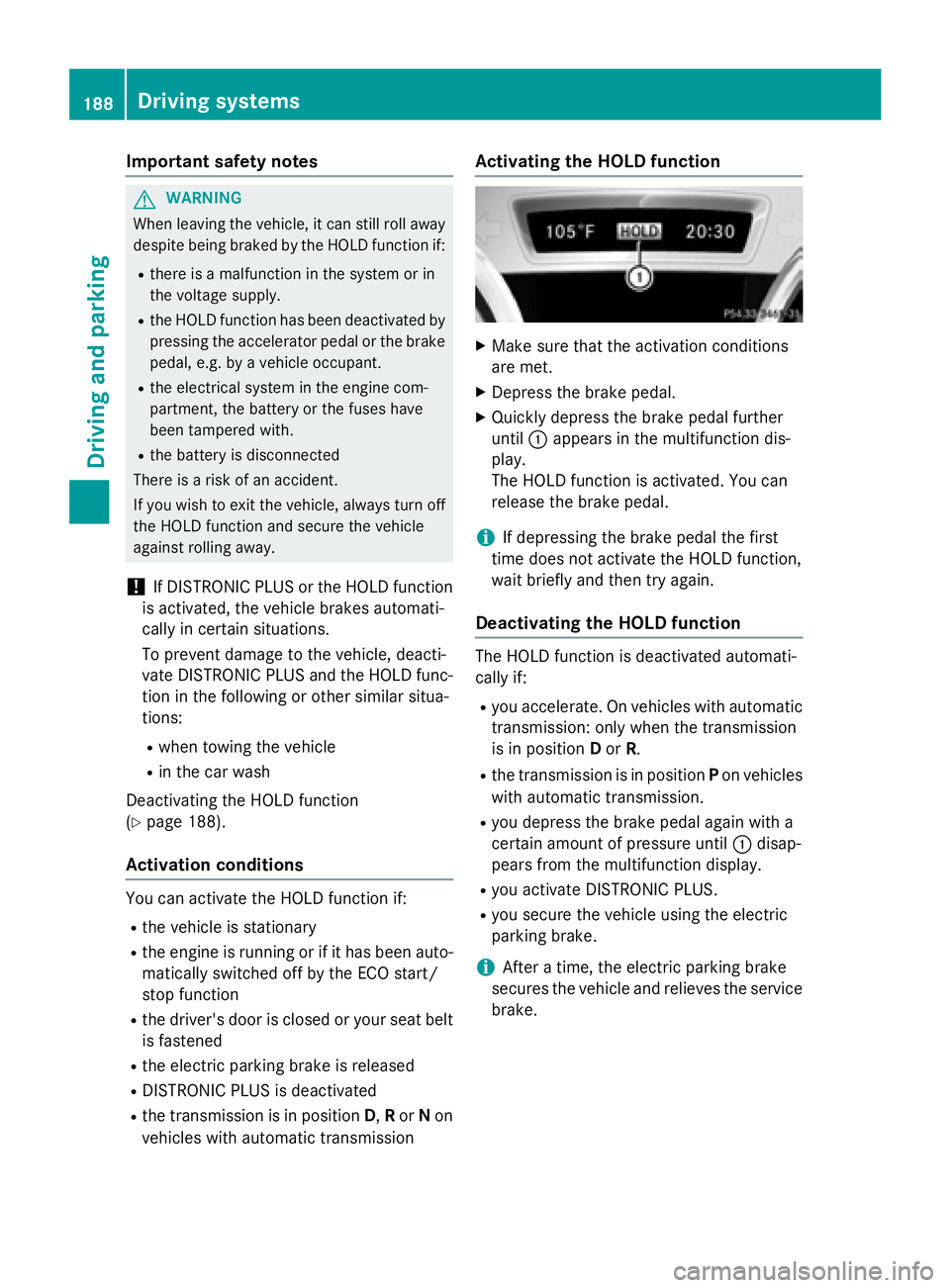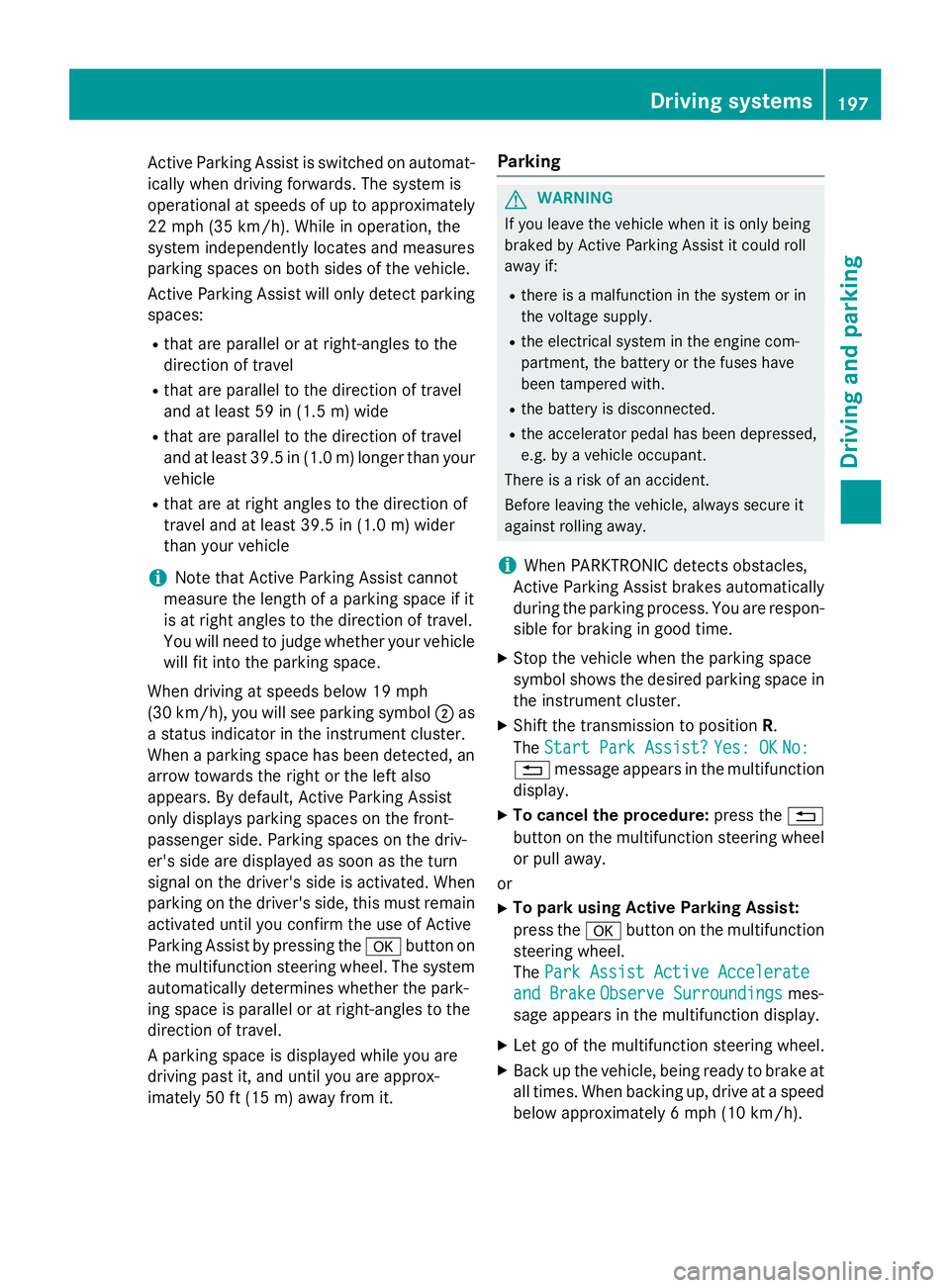2016 MERCEDES-BENZ CLA fuse
[x] Cancel search: fusePage 12 of 374

ESP ®
(Electronic Stability Pro-
gram)
AMG menu (on-board computer) .. .2 24
Characteristics ................................. 69
Deactivating/activating (button
in Mercedes-AMG vehicles) ............. 70
Deactivating/activating (except
Mercedes ‑ AMG vehicles) ................. 70
Deactivating/activating (on-
board computer, except
Mercedes-AMG vehicles) .............. .2 19
Display message ............................ 228
Function/notes ................................ 69
General notes .................................. 69
Important safety information ........... 69
Trailer stabilization ........................... 72
Warning lamp ................................. 263
ETS/4ETS (Electronic Traction Sys-
tem) ...................................................... 69
Exhaust
see Exhaust pipe
Exhaust check ................................... 173
Exhaust pipe
Cleaning ......................................... 306
Exterior lighting
Cleaning ......................................... 305
see Lights
Exterior mirrors
Adjusting ....................................... 107
Dipping (automatic) ....................... 108
Folding in when locking (on-board
computer) ...................................... 223
Folding in/out (automatically) ....... 108
Folding in/out (electrically) ........... 107
Out of position (troubleshooting) ... 108
Setting ........................................... 108
Storing settings (memory func-
tion) ............................................... 110
Storing the parking position .......... 109
Eyeglasses compartment ................. 273
F
Filler cap
see Refueling
Flat tire
MOExtended tires .......................... 311
Preparing the vehicle ..................... 310 TIREFIT kit ...................................... 312
Floormats ........................................... 294
Fog lamps
Switching on/off ........................... 115
Frequencies
Mobile phone ................................. 362
Two-way radio ................................ 362
Front fog lamps
Display message ............................ 241
Switching on/off ........................... 115
Fuel
Additives ........................................ 367
Consumption information .............. 367
Consumption statistics .................. 214
Displaying the current consump-
tion ................................................ 214
Displaying the range ...................... 214
Driving tips .................................... 173
E10 ................................................ 366
Flexible fuel vehicles ...................... 367
Fuel gauge ....................................... 31
Grade (gasoline) ............................ 366
Important safety notes .................. 365
Problem (malfunction) ................... 169
Refueling ........................................ 167
Tank content/reserve fuel ............. 366
Fuel filler flap
Opening ......................................... 168
Fuel level
Calling up the range (on-board
computer) ...................................... 214
Fuel tank
Capacity ........................................ 366
Problem (malfunction) ................... 169
Fuses
Allocation chart ............................. 326
Before changing ............................. 325
Fuse box in the engine compart-
ment .............................................. 325
Fuse box in the front-passenger
footwell .......................................... 326
Important safety notes .................. 325
G
Garage door opener
Clearing the memory ..................... 292
General notes ................................ 28910
Index
Page 185 of 374

If there is no vehicle in front, DISTRONIC
PLUS operates in the same way as cruise
control.
If DISTRONIC PLUS detects that the vehicle in
front has slowed down, it brakes your vehicle.
In this way, the distance you have selected is
maintained.
If DISTRONIC PLUS detects a faster-moving
vehicle in front, it increases the driving speed.
The vehicle is only accelerated up to the
speed you have stored.
Selecting the drive program
DISTRONIC Plus supports a sporty driving
style when you select the S+ (Mercedes-AMG
vehicles only) or S ( Y
page 162) drive program
or the manual gearshift ( Y
page 164). Accel-
eration behind the vehicle in front or to the set
speed is then noticeably more dynamic. If you
have selected the E (Mercedes-AMG vehicles:
C ) drive program, the vehicle accelerates
more gently. This setting is recommended in
stop-and-start traffic.
Changing lanes
If you change to the passing lane, DISTRONIC
PLUS supports you when: R
you are driving faster than 43 mph
(70 km/h) R
DISTRONIC PLUS is maintaining the dis-
tance to a vehicle in front R
you switch on the appropriate turn signal R
DISTRONIC PLUS does not detect a danger
of collision
If these conditions are fulfilled, your vehicle is
accelerated. Acceleration will be interrupted
if changing lanes takes too long or if the dis-
tance between your vehicle and the vehicle in
front becomes too small. Stopping
G WARNING
When leaving the vehicle, even if it is braked
only by DISTRONIC PLUS, it could roll away if: R
there is a malfunction in the system or in
the voltage supply. R
DISTRONIC PLUS has been deactivated
with the cruise control lever, e.g. by a vehi-
cle occupant or from outside the vehicle. R
the electrical system in the engine com-
partment, the battery or the fuses have
been tampered with. R
the battery is disconnected. R
the accelerator pedal has been depressed,
e.g. by a vehicle occupant.
There is a risk of an accident.
If you wish to exit the vehicle, always turn off
DISTRONIC PLUS and secure the vehicle
against rolling away.
For further information on deactivating
DISTRONIC PLUS ( Y
page 185).
If DISTRONIC PLUS detects that the vehicle in
front is stopping, it brakes your vehicle until it
is stationary.
Once your vehicle is stationary, it remains
stationary and you do not need to depress the
brake.
i After a time, the electric parking brake
secures the vehicle and relieves the service
brake.
i Depending on the specified minimum dis-
tance, your vehicle will come to a standstill
at a sufficient distance behind the vehicle in
front. The specified minimum distance is
set using the control on the cruise control
lever. Driving systems 183
Driving and parking Z
Page 190 of 374

Important safety notes
G WARNIN G
When leaving th e vehicle, it can still rol l away
despit e bein g braked by th e HOLD function if:R
there is a malfunction in th e system or in
th e voltag e supply.R
th e HOLD function has been deactivated by
pressin g th e accelerato r pedal or th e brak e
pedal , e.g. by a vehicl e occupant .R
th e electrical system in th e engin e com-
partment, th e battery or th e fuses have
been tampered with. R
th e battery is disconnected
Ther e is a ris k of an accident.
If you wish to exit th e vehicle, always tur n off
th e HOLD function and secure th e vehicl e
against rollin g away.
! If DI ST RONIC PLUS or the HOLD function
is activated, the vehicle brakes automat i-
cally in certain situations.
To prevent damage to the vehicle, deacti-
vate DI ST RONIC PLUS and the HOLD func-
tion in the fol lowin g or other similar situa-
tions: R
when to win g the vehicleR
in the car wash
Deactivating the HOLD function
( Y
page 188).
Activation conditions
You can activate the HOLD function if: R
the vehicle is stationaryR
the engine is running or if it has been auto-
matical ly swit ched off by the ECO start/
stop function R
the driv er's door is closed or your seat belt
is fastened R
the electr ic parking brake is releasedR
DI ST RONIC PLUS is deactivatedR
the transmission is in position D , R or N on
vehicles wit h automatic transmission Activating the HOLD function X
Make sure that the act ivat ion cond it ions
are met. X
Depress the brake pedal. X
Quickly depr ess the brake pedal further
unt il �C appears in the multifunction dis-
play.
The HOLD function is act ivat ed. You can
release the brake pedal.
i If depr essing the brake pedal the first
time does not activate the HOLD function,
wait brie fly and then try again.
Deactivating the HOLD function
The HOLD function is deactivated automat i-
cally if: R
you accelerate. On vehicles wit h automat ic
transmission: on ly when the transmission
is in pos it ion D or R . R
the transmission is in pos it ion P on vehicles
wit h automat ic transmission. R
you depress the brake pedal again wit h a
certain amount of pressure unt il �C disap-
pears from the multifunction display. R
you act ivat e DI ST RONIC PLU S.R
you secure the vehicle using the electr ic
parking brake.
i After a time, the electr ic parking brake
secures the vehicle and relieves the ser vic e
brake.188
Driving systems
Driving and parking
Page 199 of 374

Active Parking Assist is switched on automat-
ically when driving forwards. The system is
operational at speeds of up to approximately
22 mph (35 km/h). While in operation, the
system independently locates and measures
parking spaces on both sides of the vehicle.
Active Parking Assist will only detect parking
spaces: R
that are parallel or at right-angles to the
direction of travel R
that are parallel to the direction of travel
and at least 59 in (1.5 m) wideR
that are parallel to the direction of travel
and at least 39.5 in (1.0 m) lo nger than your
vehicle R
that are at right angles to the direction of
travel and at least 39.5 in (1.0 m) wide r
than your vehicle
i Note that Active Parking Assist cannot
measure the length of a parking space if it
is at right angles to the direction of travel.
You will need to judge whether your vehicle
will fit into the parking space.
When driving at speeds below 19 mph
(30 km/h), you will see parking symbol �D as
a status indicator in the instrument cluster.
When a parking space has been detected, an
arrow towards the right or the left also
appears. By default, Active Parking Assist
onl y d isplays parking spaces on the front-
p assenger side. Parking spaces on the driv-
er's side are displayed as soon as the turn
signal on the driver's side is activated. When
parking on the driver's side, this must remain
activated until you confirm the use of Active
Parking Assist by pressing the �v button on
the multifunction steering wheel. The system
automatically determines whether the park-
ing space is parallel or at right-angles to the
direction of travel.
A parking space is displayed while you are
driving past it, and until you are approx-
imately 50 ft (15 m) away from it. Parking
G WARNING
If you leave the vehicle when it is only being
braked by Active Parking Assist it could roll
away if: R
there is a malfunction in the system or in
the voltage supply. R
the electrical system in the engine com-
partment, the battery or the fuses have
been tampered with. R
the battery is disconnected. R
the accelerator pedal has been depressed,
e.g. by a vehicle occupant.
There is a risk of an accident.
Before leaving the vehicle, always secure it
against rolling away.
i When PARKTRONIC detects obstacles,
Active Parking Assist brakes automatically
during the parking process. You are respon-
sible for braking in good time. X
Stop the vehicle when the parking space
symbol shows the desired parking space in
the instrument cluster. X
Shift the transmission to position R .
The Start Park Assist? Yes: OK No:
�8 message appears in the multifunction
display. X
To cancel the procedure: press the �8
button on the multifunction steering wheel
or pull away.
or X
To park using Active Parking Assist:
press the �v button on the multifunction
steering wheel.
The Park Assist Active Accelerate
and Brake Observe Surroundings mes-
sage appears in the multifunction display. X
Let go of the multifunction steering wheel. X
Back up the vehicle, being ready to brake at
all times. When backing up, drive at a speed
below approximately 6 mph (10 km/h). Driving system s 197
Dr ivi ng an d parking Z
Page 311 of 374

Useful information ............................ 310
Where will I find...? ........................... 310
Flat tire .............................................. 310
Battery (vehicle) ................................ 315
Jump-starting .................................... 319
Towing and tow-starting .................. 321
Fuses .................................................. 325 309
Breakdown assistance
Page 327 of 374

Tow-starting (emergency engine
starting)
! Vehicles with automatic transmission
must not be tow-started. You could other-
wise damage the automatic transmission.
i You can find information on "Jump-start-
ing" under ( Y
page 319).
Fuses
Important safety notes
G WARNING
If you manipulate or bridge a faulty fuse or if
you replace it with a fuse with a higher amper-
age, the electric cables could be overloaded.
This could result in a fire. There is a risk of an
accident and injury.
Always replace faulty fuses with the specified
new fuses having the correct amperage.
Blown fuses must be replaced with fuses of
the same rating, which you can recognize by
the color and value. The fuse ratings are listed
in the fuse allocation chart.
If a newly inserted fuse also blows, have the
cause traced and rectified at a qualified spe-
cialist workshop, e.g. an authorized
Mercedes-Benz Center.
! Only use fuses that have been approved
for Mercedes-Benz vehicles and which
have the correct fuse rating for the system
concerned. Only use fuses marked with an
"S". Otherwise, components or systems
could be damaged.
The fuses in your vehicle serve to close down
faulty circuits. If a fuse blows, all the compo-
nents on the circuit and their functions stop
operating. Before changing a fuse X
Secure the vehicle against rolling away
( Y
page 169). X
Switch off all electrical consumers. X
Vehicles without KEYLESS-GO: remove
the SmartKey from the ignition lock. X
Vehicles with KEYLESS-GO start-func-
tion or KEYLESS-GO: open the driver's
door.
The on-board electronics now have status
0 . This is the same as the SmartKey having
been removed.
The fuses are located in various fuse boxes: R
Fuse box in the engine compartment on the
left-hand side of the vehicle, when viewed
in the direction of travel R
Fuse box in the front-passenger footwell
The fuse allocation chart is on the fuse box in
the front-passenger footwell ( Y
page 326).
Fuse box in the engine compartment
G WARNING
When the hood is open and the windshield
wipers are set in motion, you can be injured by
the wiper linkage. There is a risk of injury.
Always switch off the windshield wipers and
the ignition before opening the hood.
! Make sure that no moisture can enter the
fuse box when the cover is open.
! When closing the cover, make sure that it
is lying correctly on the fuse box. Moisture
seeping in or dirt could otherwise impair
the operation of the fuses. Fuses 325
Breakdown assistance Z
Page 328 of 374

X
Open the hood. X
Use a dry cloth to remove any moisture
from the fuse box. X
To open: open clamps �D .X
Fold up cover �C in the direction of the
arrow and remove it.
X
To close: check whether the seal is lying
correctly in cover �C .X
Insert cover �C at the back into openings
�